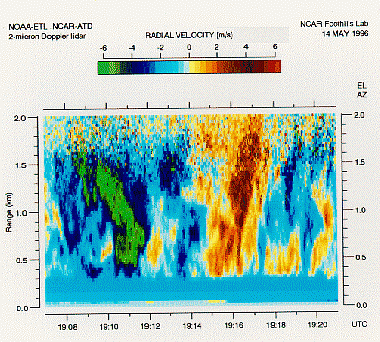Doppler lidar
|
B. Geerts |
3/’02 |
|
Lidars (Light detection and ranging) are, like radars, emit electromagnetic radiation and collect the echo return, to remotely sense atmospheric characteristics. Unlike radars, lidars work in the visible spectrum, and therefore the return is dominated by background radiation (mainly from the Sun). Lidars work in clear air, and their signal is scattered mainly by aerosols. Doppler lidars measure the phase shift between two consecutive signals from the same echo, and this yields the radial velocity of the echo. There are various types of Doppler lidar, most of them are used for studies of the PBL (Fig 1) (1). Fig 1 (right). A time-height display of vertical profiles of the vertical wind acquired by a Doppler lidar in Boulder, CO, in 14 May 1996. Positive velocities (red) indicate rising air motions. The column of high downward motion (green) between 19:10 and 19:12 UTC is a shaft of light rain. This lidar has a range resolution of 30 m, a velocity resolution of about 5 m/s, and a time resolution of less than 10 sec. (Source: NOAA Environmental Technology Lab, Optical Remote Sensing Division) |
|
Reference
(1) Cohn, S. et al 1998. The 1996 Lidars in Flat Terrain (LIFT) experiment. Bull. Amer. Meteor. Soc., 79, 1329–1343
